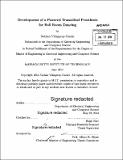Development of a powered transtibial prosthesis for ball room dancing
Author(s)
Villagaray-Carski, Nathan (Nathan C.)
DownloadFull printable version (6.645Mb)
Alternative title
Development of a bionic dancing prosthesis
Other Contributors
Massachusetts Institute of Technology. Department of Electrical Engineering and Computer Science.
Advisor
Hugh Herr.
Terms of use
Metadata
Show full item recordAbstract
Research on lower extremity prostheses has primarily focused on activities of daily living, such as walking and running, but has largely overlooked less common activities. As a result, traditional prosthetic devices are designed for a walking/running gait, and are difficult to use for other activities. This study aims to take the first steps to determine if a bionic prosthesis can enable alternate activity modes, not driven by traditional activities of daily living. Specifically, we aim to modify the BiOM, a commercial robotic ankle prosthesis, to allow a professional dancer and below-knee amputee to dance the Rumba. The movements of an able-bodied professional dancer were quantified and analyzed in order to develop a novel dance control system for the BiOM. With minimal hardware modifications, a powered prosthetic device was developed that enables the subject to dance more proficiently than with a traditional prosthesis.
Description
Thesis: M. Eng., Massachusetts Institute of Technology, Department of Electrical Engineering and Computer Science, 2014. Cataloged from PDF version of thesis. Includes bibliographical references (pages 37-38).
Date issued
2014Department
Massachusetts Institute of Technology. Department of Electrical Engineering and Computer SciencePublisher
Massachusetts Institute of Technology
Keywords
Electrical Engineering and Computer Science.